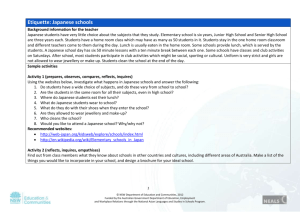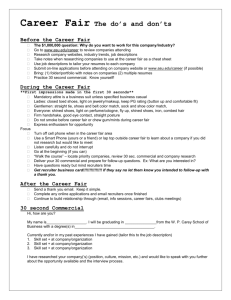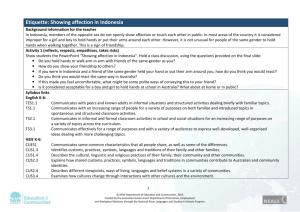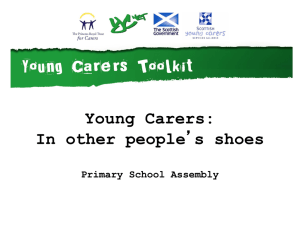Sample activities - Our Asian Stories
advertisement
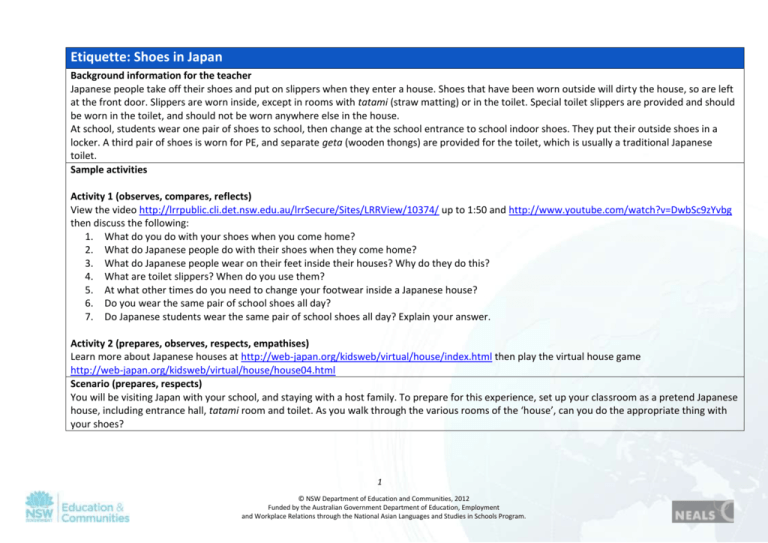
Etiquette: Shoes in Japan Background information for the teacher Japanese people take off their shoes and put on slippers when they enter a house. Shoes that have been worn outside will dirty the house, so are left at the front door. Slippers are worn inside, except in rooms with tatami (straw matting) or in the toilet. Special toilet slippers are provided and should be worn in the toilet, and should not be worn anywhere else in the house. At school, students wear one pair of shoes to school, then change at the school entrance to school indoor shoes. They put their outside shoes in a locker. A third pair of shoes is worn for PE, and separate geta (wooden thongs) are provided for the toilet, which is usually a traditional Japanese toilet. Sample activities Activity 1 (observes, compares, reflects) View the video http://lrrpublic.cli.det.nsw.edu.au/lrrSecure/Sites/LRRView/10374/ up to 1:50 and http://www.youtube.com/watch?v=DwbSc9zYvbg then discuss the following: 1. What do you do with your shoes when you come home? 2. What do Japanese people do with their shoes when they come home? 3. What do Japanese people wear on their feet inside their houses? Why do they do this? 4. What are toilet slippers? When do you use them? 5. At what other times do you need to change your footwear inside a Japanese house? 6. Do you wear the same pair of school shoes all day? 7. Do Japanese students wear the same pair of school shoes all day? Explain your answer. Activity 2 (prepares, observes, respects, empathises) Learn more about Japanese houses at http://web-japan.org/kidsweb/virtual/house/index.html then play the virtual house game http://web-japan.org/kidsweb/virtual/house/house04.html Scenario (prepares, respects) You will be visiting Japan with your school, and staying with a host family. To prepare for this experience, set up your classroom as a pretend Japanese house, including entrance hall, tatami room and toilet. As you walk through the various rooms of the ‘house’, can you do the appropriate thing with your shoes? 1 © NSW Department of Education and Communities, 2012 Funded by the Australian Government Department of Education, Employment and Workplace Relations through the National Asian Languages and Studies in Schools Program. Syllabus links English K-6: TES1.1 Communicates with peers and known adults in informal situations and structured activities dealing briefly with familiar topics. TS1.1 Communicates with an increasing range of people for a variety of purposes on both familiar and introduced topics in spontaneous and structured classroom activities. TS2.1 Communicates in informal and formal classroom activities in school and social situations for an increasing range of purposes on a variety of topics across the curriculum. TS3.1 Communicates effectively for a range of purposes and with a variety of audiences to express well-developed, well-organised ideas dealing with more challenging topics. HSIE K-6: CUES1 Communicates some common characteristics that all people share, as well as some of the differences. CUS1.3 Identifies customs, practices, symbols, languages and traditions of their families and other families. CUS1.4 Describes the cultural, linguistic and religious practices of their family, their community and other communities. CUS2.3 Explains how shared customs, practices, symbols, languages and traditions in communities contribute to Australian and community identities. CUS2.4 Describes different viewpoints, ways of living, languages and belief systems in a variety of communities. Japanese K-10: 1.MBC.1 Demonstrates awareness of cultural diversity. 1.MBC.2 Identifies cultural practices in Japanese-speaking communities. 2.MBC.1 Recognises the link between culture and a sense of identity. 3.MBC.2 Demonstrates understanding of significant cultural values and practices in Japanese-speaking communities. 4.MBC.2 Demonstrates knowledge of key features of the culture of Japanese-speaking communities. Disclaimer: The NSW Department of Education and Communities cannot guarantee the availability or content of external links. Please check websites yourself for suitability before showing to students. Show YouTube videos in full-screen mode, so that posted comments cannot be viewed by students. 2 © NSW Department of Education and Communities, 2012 Funded by the Australian Government Department of Education, Employment and Workplace Relations through the National Asian Languages and Studies in Schools Program.

